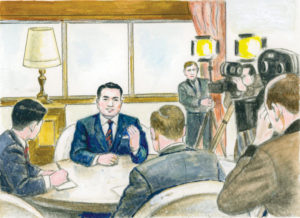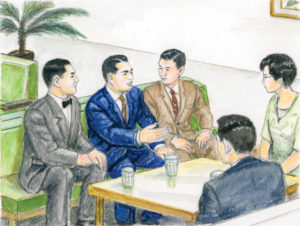Chapter Summary

Illustration courtesy of Seikyo Press.
Shin’ichi Yamamoto made sure that all Soka Gakkai activities were successful leading up to the seventh memorial[1] of the passing of his mentor, second Soka Gakkai President Josei Toda. The memorial services took place over two days in early April 1964 at the head temple’s newly completed Grand Reception Hall, which had been completely funded by Soka Gakkai members.
During the services, Shin’ichi discussed Mr. Toda’s novel, Human Revolution, which details his journey after being released from prison. He also declared that the Soka Gakkai had entered the struggle of the essential phase, in which Buddhism would spread widely throughout society.
At the headquarters general meeting on May 3, Shin’ichi presented several goals for the next seven years, which included completing the building of a Grand Main Temple and achieving a membership of six million households. Fresh sails had been hoisted for departure into a new era.
On May 12, Shin’ichi departed for the Philippines, Australia, Ceylon (now Sri Lanka) and India. While in Australia, he established Melbourne Chapter and wholeheartedly encouraged the members fighting for kosen-rufu there.
Around this time, false information about the Soka Gakkai based on misunderstandings and prejudice had spread throughout the English-speaking world through various media outlets. During an interview with an Australian TV crew, Shin’ichi clarified the truth about the Soka Gakkai.
Shortly after returning to Japan from India, Shin’ichi received the shocking news that Indian Prime Minister Jawaharlal Nehru had passed away. Shin’ichi vowed to spread the philosophy of human harmony and peace as quickly as possible.
Unforgettable Scene

Illustration courtesy of Seikyo Press.
The Harder the Conditions We Face, the Greater the Benefits We Gain
On May 12, 1964, on his way to Australia, Shin’ichi Yamamoto made a stopover in Manila, Philippines. There, he encouraged a local member named Kikuko Itami, who had been struggling.
Kikuko [Itami] put her all into Soka Gakkai activities in Manila. But because of the strong influence of Catholicism in the Philippines and perhaps also due to cultural differences, sharing the Daishonin’s teachings with people there proved quite difficult. In addition, anti-Japanese sentiment resulting from the Japanese invasion of the Philippines during World War II remained.
■ ■ ■
Kikuko Itami began explaining the situation in the Philippines to Shin’ichi [Yamamoto]: “Sensei, we are not making much progress with kosen-rufu in the Philippines …
“Catholicism is deeply rooted in the people’s lives, which makes it difficult for people to understand and accept the teachings of Buddhism … ”
Kikuko looked weary as she spoke. Shin’ichi could see how she had struggled each day to overcome the obstacles she was facing in her new country. He spoke to her warmly: “I understand your hardship. But true Buddhist practice means sharing faith with others in the most difficult of circumstances. As the Gosho says: ‘A hundred years of practice in the Land of Perfect Bliss cannot compare to the benefit gained from one day’s practice in the impure world’ (“On Repaying Debts of Gratitude,” The Writings of Nichiren Daishonin, vol. 1, p. 736). The ‘impure world’ is this world we live in, with all its harsh realities. But the harder the conditions we face, the greater the benefits we gain by working wholeheartedly to spread the Daishonin’s teachings.
“Furthermore, Bodhisattvas of the Earth are everywhere. It is impossible that the Philippines would be the only place in the world where they would not appear. You need not worry. As long as you pray earnestly for the realization of kosen-rufu and continue to talk about Buddhism with others, you will definitely be able to help people here take up faith.”
The Gosho elucidates the extreme difficulty of achieving kosen-rufu. Carrying out the sacred undertaking bequeathed to us by the Buddha of the Latter Day of the Law is no easy feat … Kikuko had hit a brick wall despite her sincere efforts and this was seriously troubling her. What she needed more than anything was encouragement.
Guidance takes many forms. It’s important to carefully and thoroughly explain what it means to have faith in the Daishonin’s Buddhism to those who don’t understand it … And we should offer praise and encouragement to those who are making great efforts in their practice. (The New Human Revolution, vol. 9, pp. 48–50)
Key Passage
The basis of consideration is prayer. People always open up to and have good feelings toward those who pray for and care about their happiness. (NHR-9, 62)
References
- Seventh memorial: According to Japanese tradition, the first memorial service is held immediately after a person’s death as the funeral service. The second memorial service is held on the first anniversary of that occasion and so on. ↩︎
You are reading {{ meterCount }} of {{ meterMax }} free premium articles

